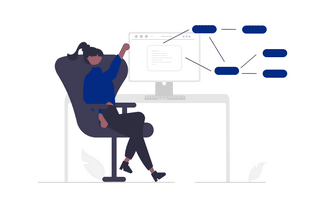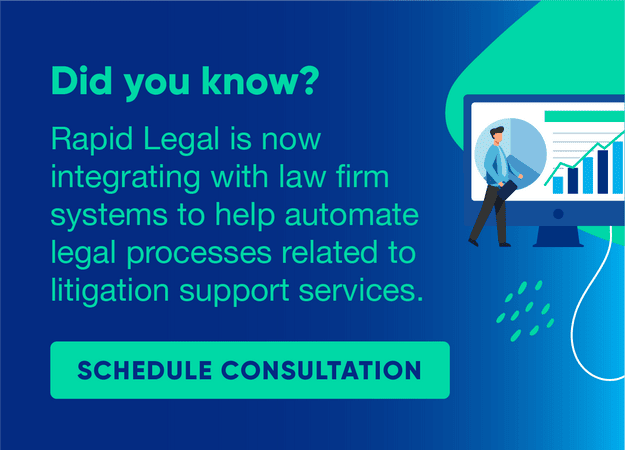
There’s no better time than now for law firms to reimagine the role technology plays in improving operational efficiency and delivery of service. That’s why firms looking to use technology to meet long-term challenges in the marketplace need a well-planned digital transformation road map.
It’s a big job but it can deliver big results. If you’re on the fence about whether this transformation is right for your law firm, consider that a growing majority of California courts now accept electronic court document filing (eFiling) and many courts make eFiling mandatory.
With that in mind, you may be wondering whether you’ll need that map sooner than you think.
Here’s how to build it.

What Digital Transformation Means for a Law Firm
Lawyers have been said to embrace change at roughly the same speed as molasses flowing in winter. That may be changing, however, according to recent statistics that suggest law firms and legal professionals are ready to embrace technology.
Here are a few numbers that shake up the stereotype:
58% Percentage of law firms that use the cloud. | 60% Percentage of lawyers who believe their firm is ready to adopt new technology to perform routine tasks. | 27% Percentage of law firm senior executives who believe digital transformation is a matter of survival. |
The 27% of firm executives who consider digital transformation a matter of survival send a compelling message that things are changing. But it’s not a change that should be feared.
On the contrary, for many law firms digital transformation indicates a shift toward automating processes that will yield greater efficiencies.
One of the automated processes that can lead a law firm to undertake a digital transformation is eFiling. That is because California courts are increasingly accepting electronic document filing, which means law firms must adopt eFiling if they want to operate in those courts.
In the middle of this change are litigation support service providers, which facilitate eFiling and the exchange of digital documents between law firms, courts, and other parties.
Litigation support service providers also equip law firms with the technology to adopt a paperless, online workflow. That new process reduces the amount of human labor needed to complete a court document filing, thereby lowering costs and increasing efficiency.
By using a litigation support service provider’s technology platform, a law firm can execute eFiling and many other court services 24/7 from anywhere an internet connection is available.
These benefits are highly strategic and mark digital transformation as a smart business move.
Can your litigation support service provider help your digital transformation?
Find out which future-ready technologies your provider must have.
Read 5 Signs It’s Time to Switch Your Legal Support Service Provider.

The Value of Digital Transformation
Firms that pursue a digital transformation must view the change through a macro lens, because the transformation offers far more advantages than the more granular benefits of eFiling.
Digital transformation touches nearly every operational and financial aspect of a law firm. It can change the amount of work legal professionals can accomplish as well as when and where that work gets done.
But it’s also got something for accounting staff, purchasing staff, and law firm clients. Here are five ways digital transformation spreads value across office disciplines and across the firm itself:
• Creates Efficiencies: eFiling reduces the amount of human participation needed to file court documents, making these services faster, more affordable, and more accurate. Likewise, migrating paper-based litigation support services to electronic-based, paperless services saves the firm money.
• Tracks Service Performance: Firms can use data from their litigation support service provider to evaluate how well the business is running. For example, data about service of process can uncover wasteful spending by analyzing:
✓ Service level distribution
✓ Orders by type
✓ Service of process orders by pricing zone
✓ Service of process performance
Did you know service of process data can protect your bottom line?
Find out how.
Read: Technology Your Process Server Should Be Using.
• Controls Costs: System-to-system technology integrations with vendors can help firms reduce spending and control costs. Once again, by leveraging the firm’s relationship with a litigation support service provider, invoices and service fee data can be automatically integrated with a law firm’s CRM. This reduces the time needed for accounting staff to reconcile expenses and matters.
See how a Los Angeles law firm leveraged this type of system-to-system integration in this case study.
• Provides Scalability: Systems that rely on paper documents are slow and unwieldy. In contrast, automated online processes are flexible and can be scaled up or down depending on the volume of e-filing, process serving, and other services your firm needs—and how quickly they are needed.
• Transforms Billing and Payment Systems: E-commerce transforms how your firm makes payments and receives payments. The benefits of E-commerce show in the form of billing and invoicing that is cleaner and more timely than waiting for checks to crawl through the mail.
E-commerce also uses credit card or ACH to make payments easier to manage, track, and archive. Most importantly, making payments electronically means you have a high level of transparency between your firm and your vendors.
Developing the Map
You’ve seen some of the benefits of digital transformation. Now it’s time to build the map.
The first step is to identify the specific challenges and demands of your firm’s business. Each firm’s path may vary but in general you can keep the transformation on course by following these three practices:
1. Set a goal
Digital transformation requires careful planning. Part of that planning must identify major business improvements digital transformation is expected to facilitate, which may be quite diverse.
Some firms, for example, will be interested in presenting a more tech-savvy face to clients. Others will expect the transformation to boost their operational horsepower, facilitate a remote workforce, or create greater accountability among office personnel.
Still other firms may focus on uncovering blind spots they can address with technology.
Whatever your goal, it is important to think differently about how every aspect of the firm’s technology affects clients, competition, innovation, and value.
2. Define Your Technology Strategy
Your road map should clarify the strategic role technology will play for the law firm. Make no mistake, technology ranging from the firm’s practice management software to its HR infrastructure can be used strategically. Everything should be considered.
Likewise, firms should expect strategic help from the solutions their litigation support service provider offers.
These vendors should help improve the firm’s bottom line by reducing its labor needs and paper-based work.
3. Implement the Plan
A rolling stone gathers no moss. Neither should your law firm’s digital transformation.
Develop an implementation plan and timeline to make sure your vision takes shape. These three questions will help build out your timeline and organize resources:
- What is the ideal time to begin the transformation?
- How much time will be needed to complete the transformation?
- What roles/people are needed to implement the digital transformation initiative?
Some firms will need to work around predictable peak business seasons or time off scheduled by mission-critical staff. Firms will also need to address whether traditional and digital systems should run in parallel for a brief period.

Don’t Forget About Training
Training plans are an absolute must for any digital transformation map. This single data point crystallizes the reason behind that:
70%
Percentage of complex, large-scale change programs that fail.
McKinsey & Company.
Despite that sobering statistic there are measures you can take to assure an optimum outcome for your law firm’s digital transformation. Here are four things that commonly sabotage large-scale transformation. Make sure you guard against them:
- Lack of employee engagement.
- Inadequate management support.
- Poor cross-functional collaboration.
- Lack of accountability.
If you’d like to know more about how to execute a successful digital transformation check out this advice from a global management consulting firm.
If you’re in a hurry and only have time for the highlights, Table 1 below sums them up:
Table 1.
| 1 | Due Diligence Think like an investor. Establish the arc and full potential of the transformation. |
| 2 | Plan From the Ground Up Know the initiatives, see the financial projections, know who owns what. |
| 3 | Implement, Implement, Implement Pick a launch date that makes sense and go all-in. Quickly execute on early opportunities. |
| 4 | Manage Change Communicate internally, appoint champions, change mindsets. If money is no object get a change management consultant such as KPMG, Bain & Company, or Deloitte. |
| 5 | Unleash Progress You know who your standouts are. Give them the tools and agency to assure superior execution, then stand back and let it happen. |
Change Management
While technology plays a central role in digital transformation, employee buy-in is key to the success of any transformation initiative. A great start to cultivating buy-in for your transformation initiative is involving employees across the firm early in the project. Asking employees for their ideas and feedback provides leaders with valuable insights and makes employees feel they are essential to the change.
It can’t be stressed enough how important effective communication is for any digital transformation initiative. During all stages of an initiative, from planning to implementation and beyond, well-planned and regular communications can promote buy-in by keeping employees in the loop about the goals, the benefits, the process, and the outcomes of the digital transformation initiative. You can’t achieve transformation with technology alone. The initiative needs to be fully understood and embraced by everyone within the firm.
Another way to rally support for your initiatives is to identify transformation advocates among employees. These are members of the firm who are willing to be early adopters of working with the new technology and who will serve to champion the initiative within the firm.
Planning for and ensuring that employees are adequately trained on all aspects of new technology is another success factor for any digital transformation.
Technology Selection
Before selecting a technology solution, it is helpful to undertake a complete inventory of your firm’s technology stack, including existing technical competencies and potential gaps. While the cost of the technology under consideration will be key to any decision, you’ll also want to give weight to whether the technology ensures top-notch data security, is easy to use, enables collaboration and mobility, and comes with stellar technical support. When selecting your technology provider, you will want to ensure that it is familiar with law firms and understands how they operate, how lawyers and staff work, and that it fully appreciates that the learning curve may be steep for the end-users of the new technology. Most of all, the technology provider should understand your firm’s strategy and what it is trying to achieve with the digital transformation initiative. The firm should feel that the technology provider is ready to be a true partner in the successful outcome of the initiative.
Implementation
Implementing a comprehensive digital transformation plan can be complex and take significant time and resources. A firm should be both realistic and ambitious in developing a timeline for its transformation projects. It may be wise to break the plan into smaller projects that build on each other; in other words, start small, achieve results and work from there. You’ll need a team of competent, enthusiastic experts who take responsibility for implementation, monitor progress, and ensure that milestones and goals are met on time and within budget. Implementation will require a lot of collaboration across the firm, and it is important to recognize that not everyone moves at the same pace!
Make sure to engage your technology provider’s customer success team during the implementation process. Remember, you selected them because they are willing to partner with you. A great customer success team will provide ongoing support and is available to ensure you have the best experience possible with any tech platform you adopt.

Roll With the Changes
On the whole, a law firm’s digital transformation means attorneys will have more time to focus on doing better, more creative and innovative work with the firm’s clients. That’s because tasks such as document drafting and review, legal research, eFiling, document retrieval, process serving, and more can be handed over to technology.
But digital transformation is never completely finished. It is an ongoing process that requires one eye to continually look for ways to improve the firm while maintaining buy-in from internal staff.
Advanced technology isn’t going away any time soon, so start planning your law firm’s digital transformation map today. You’ll discover that despite the challenges ahead you can get there from here.
Need help mapping out your law firm’s digital transformation?
Contact a Rapid Legal account executive to find out how our technology platform can power your future.
Get Started Today
Spend more time on billable client hours and less time tracking down conformed copies and proofs of service.

